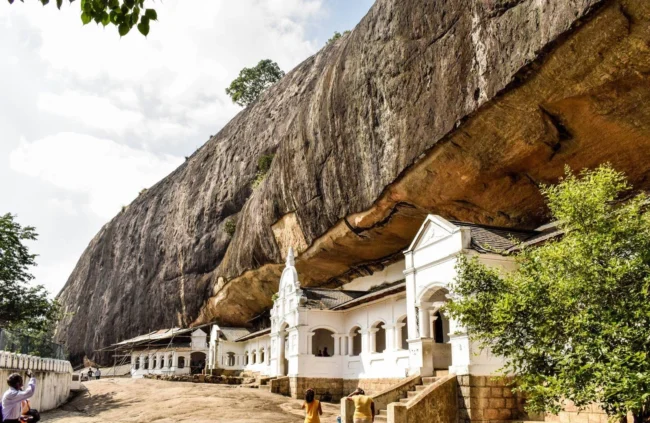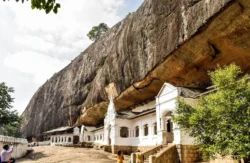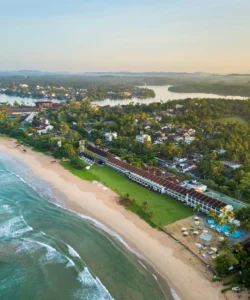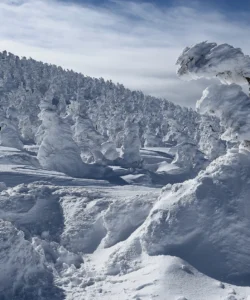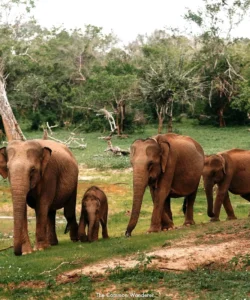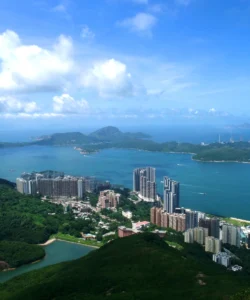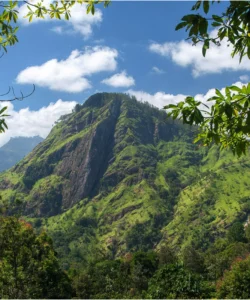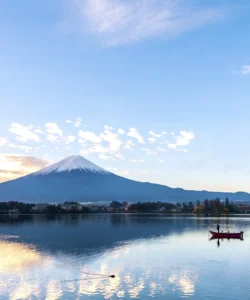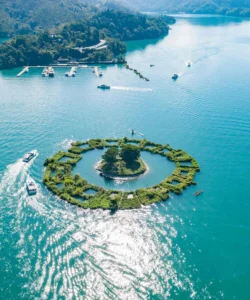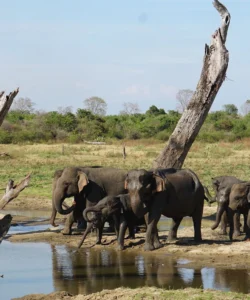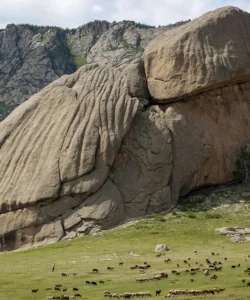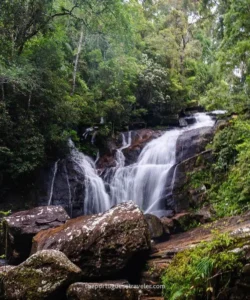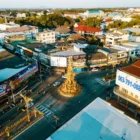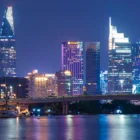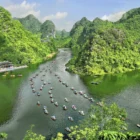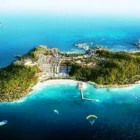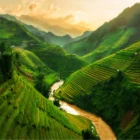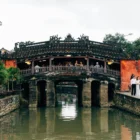The Dambulla Cave Temple, also known as the Golden Temple of Dambulla, is an extraordinary cave monastery located in the central part of Sri Lanka. A UNESCO World Heritage site, it is the largest and best-preserved cave temple complex in the country, a sacred pilgrimage site for over 2,200 years. Perched majestically within a massive rock outcrop, it features five principal caves adorned with an astounding collection of Buddha statues and vibrant murals, showcasing centuries of Sinhalese Buddhist art and devotion.
Name: Dambulla Cave Temple (දඹුල්ල රජ මහා විහාරය, Dam̆būlla Raja Maha Vihāraya; also known as the Golden Temple of Dambulla)
Address: Dambulla, Matale District, Central Province, Sri Lanka. It is situated atop a large rock, about 160 meters (520 feet) above the surrounding plains.
How to get there:
Dambulla is a central hub in Sri Lanka’s Cultural Triangle, making it relatively easy to reach:
- From Colombo (Bandaranaike International Airport – CMB) to Dambulla:
* Taxi/Private Car: The most convenient option, taking approximately 2-2.5 hours (around 148 km). You can pre-book a transfer or hire a taxi at the airport.
* Bus: Take a bus from the airport or Colombo’s Bastian Mawatha Bus Terminal towards Dambulla. This is the most budget-friendly option, but can take 3-4 hours. - From Kandy to Dambulla: Take a direct bus (Line 48) from Kandy’s main bus station to Dambulla. The journey is about 2-3 hours. Taxis are also available.
- From Sigiriya: Dambulla is very close to Sigiriya. Take a local bus (very frequent, about 30 minutes) or a tuk-tuk (about 30 minutes) from Sigiriya to Dambulla.
- Within Dambulla (to the Cave Temple):
- The caves are located on a hill overlooking the town. You can take a tuk-tuk to the base of the rock or walk from Dambulla’s central bus stand (around 20-25 minutes).
- From the base (near the Golden Temple complex), you’ll need to climb a series of steps (approximately 15-20 minutes, uphill) to reach the cave complex.
Landscape and Architecture:
The Dambulla Cave Temple is a marvel of natural geological formations transformed into a vibrant spiritual sanctuary:
- Natural Cave Complex: The primary “architecture” consists of five main caves (shrine rooms) nestled under a vast, overhanging rock outcrop. These are natural caverns that have been continuously used and embellished for millennia.
- Statue Gallery: The caves house an incredible collection of 153 Buddha statues, along with three statues of Sri Lankan kings and four statues of Hindu gods and goddesses (including Vishnu and Ganesha), showcasing the syncretic nature of local beliefs. The statues are in various sizes and postures (seated, standing, reclining), some carved directly from the living rock.
- Cave 1 (Devaraja Lena – “Cave of the Divine King”): Dominated by a 14-meter (45-foot) reclining Buddha statue, hewn out of the rock, representing the Buddha’s final passing (Parinirvana).
- Cave 2 (Maharaja Lena – “Cave of the Great Kings”): The largest and most impressive cave, featuring a diverse collection of statues, including a large stupa and statues of King Valagamba and King Nissankamalla.
- Cave 3 (Maha Alut Viharaya – “Great New Temple”): Dating from the 18th century, with a 9-meter (30-foot) reclining Buddha and numerous other statues.
- Mural Paintings: The interiors of the caves, including the undulating ceilings and walls (covering an area of 2,100 square meters or 23,000 sq ft), are entirely covered with vibrant and intricate mural paintings. These depict scenes from the Buddha’s life, Jataka tales (stories of the Buddha’s previous lives), and important historical events. While some date to the 1st century BCE, many were repainted or added in the 17th and 18th centuries, showcasing the evolution of Sinhalese painting styles.
- Drip-Line Carvings: Ancient engineers carved drip lines into the overhanging rock to keep the cave interiors dry, a testament to early ingenuity.
- Golden Temple (Modern): At the base of the rock, a more recent (completed in 2000 with Japanese funding) and somewhat kitschy complex called the Golden Temple features a massive golden Buddha statue and a museum. This acts as the ticket office for the cave temple.
- Panoramic Views: From the top of the rock, visitors are treated to panoramic views of the surrounding plains, including the iconic Sigiriya Rock Fortress in the distance.
- Pilgrimage Path: The ascent to the caves is a pilgrimage in itself, often shared with playful toque macaques.
What makes it famous:
Dambulla Cave Temple is famous for:
- UNESCO World Heritage Site: Inscribed in 1991, recognized for its exceptional preservation, artistic value, and its continuous function as a Buddhist pilgrimage site for over two millennia.
- Largest and Best-Preserved Cave Temple: It is unparalleled in Sri Lanka for its size, the number of its Buddha statues, and the extent and quality of its murals.
- Centuries of Buddhist Art: The caves offer a continuous historical record of Sinhalese Buddhist art, with layers of paintings and statues spanning from the 1st century BCE to the 18th century.
- Impressive Collection of Buddha Statues: The sheer number and variety of Buddha images, many carved directly from the rock, are awe-inspiring.
- Historical Significance: Its association with King Valagamba (1st century BCE), who took refuge here and later converted the caves into a temple, adds to its legendary status.
- Active Buddhist Site: It is a living monastery, with monks still in residence and daily rituals being performed, offering a genuine glimpse into Buddhist practice.
- Panoramic Views: The climb to the caves is rewarded with stunning views of the surrounding landscape, including the famous Sigiriya Rock.
Differences from some other wonders:
The Dambulla Cave Temple distinguishes itself from other temples and artificial caves in several profound ways:
- Natural Caves Transformed, Not Excavated: Unlike carved-out monolithic cave temples (e.g., Ellora Caves) or built-up grottoes (e.g., Seokguram), Dambulla utilizes pre-existing natural rock overhangs and caverns, which were then artistically enhanced and converted into magnificent shrines. This “natural canvas” approach is distinct.
- Continuous Artistic Embellishment: Its continuous embellishment with murals and statues over two millennia by various kings (rather than a single period of creation) means it offers a unique, layered historical record of evolving Sinhalese art styles within the same sacred space.
- Remarkable Preservation of Murals: The extensive and relatively well-preserved ancient mural paintings covering vast areas of the cave ceilings and walls are a major highlight, showcasing a style unique to Sri Lanka, and in a scale rarely seen in other cave temples globally.
- Syncretic Pantheon in a Buddhist Site: While predominantly Buddhist, the explicit and revered presence of Hindu deities (Vishnu, Ganesha) alongside Buddha statues within a primary Buddhist temple complex highlights a specific aspect of religious syncretism unique to Sri Lankan Buddhism, often found in traditional Kandyan-era temples.
- Proximity to Other Cultural Triangle Sites: Its central location within Sri Lanka’s “Cultural Triangle” means it is perfectly positioned to be visited alongside other major UNESCO sites like Sigiriya and Polonnaruwa, forming part of a rich historical pilgrimage route.
- The “Golden Temple” at the Base: The modern, gilded “Golden Temple” complex at the foot of the rock, with its massive golden Buddha statue, provides a striking and somewhat kitschy modern contrast to the ancient, serene caves above, creating a unique visual experience upon arrival.
In essence, the Dambulla Cave Temple is a profound and visually stunning wonder, a living masterpiece of Buddhist art and a testament to centuries of unwavering faith, all carved into the very heart of Sri Lanka’s ancient landscape.
